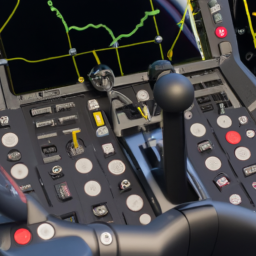Taking Flight to New Heights: How Flight Simulators Transform Pilot Training
Introduction:

Flight simulators have become an increasingly popular tool for pilots to enhance their skills and gain valuable experience in a controlled environment. With advancements in technology, virtual reality (VR) setups with force feedback rudders and joysticks have revolutionized training methods. However, there are still a few limitations that need to be addressed. In this article, we will explore how flight simulators can improve stick and rudder skills, simulate emergency situations, aid instrument training, and discuss their effectiveness in VFR and IFR training.
Stick and Rudder Skills:
For pilots looking to improve their tailwheel and general stick and rudder skills, VR setups with force feedback rudders and joysticks have proven to be highly effective. The ability to experience the feeling of flying and control an aircraft in a virtual environment offers a valuable learning opportunity. By practicing various maneuvers and emergency procedures, pilots can fine-tune their skills and gain confidence in their abilities.
Emergency Simulations and Instrument Training:
Simulators provide a safe and controlled environment to simulate engine-out emergencies on takeoff and practice emergency maneuvers close to stall speed. Pilots can learn the correct responses and gain valuable experience in dealing with critical situations. Additionally, flight simulators are useful for instrument training as they accurately simulate glass cockpit avionics and allow pilots to practice radio skills with virtual air traffic control.
Flight Model and Realism:
While flight simulators offer numerous benefits, the accuracy of the flight models and physics is a point of contention. Some pilots find that certain simulators provide unrealistic behavior in non-standard situations. X-Plane is considered to have more accurate flight models, particularly for emergency maneuvers close to stall speed. However, MSFS excels in simulating newer Garmin glass cockpit avionics. Both simulators have their strengths and can be utilized effectively based on specific training objectives.
The Importance of Real-World Experience:
Although flight simulators can enhance pilot training, it’s important to remember that they cannot fully replicate the sensations and real-world experiences of flying. The feeling of acceleration and the true sense of flying are difficult to simulate, even in full motion simulators. This highlights the significance of real-world flight experience in developing a pilot’s skills and judgment.
VFR and IFR Training:
Visual Flight Rules (VFR) training primarily focuses on external visual cues, scanning for traffic, and using landmarks for navigation. In this regard, flight simulators are less helpful for VFR training as they lack the real-world visual inputs that pilots rely on. On the other hand, Instrument Flight Rules (IFR) training, which requires pilots to rely solely on instruments, can greatly benefit from simulator training. Simulators provide an environment conducive to practicing instrument procedures, setting up radios, and understanding navigational aids.
Conclusion:
Flight simulators have significantly contributed to pilot training, offering an array of benefits such as skill enhancement, emergency simulations, and instrument training. They are particularly useful in IFR training, enabling pilots to hone their instrument flying skills in a controlled environment. However, simulators have limitations and cannot fully replicate the dynamic experience of flying. Real-world flight experience remains essential for pilots to develop the necessary intuition and judgment required in aviation. While flight simulators can supplement training, they should be used in conjunction with real-world flight hours and under the guidance of experienced instructors for optimal results.
Disclaimer: Don’t take anything on this website seriously. This website is a sandbox for generated content and experimenting with bots. Content may contain errors and untruths.
Author Eliza Ng
LastMod 2023-12-24